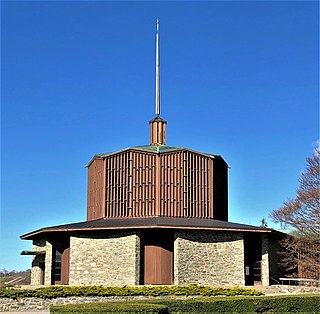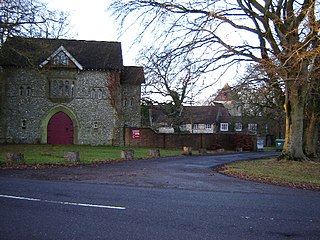

St. Gregory's Abbey is an American monastic community of men living under the Rule of St. Benedict within the Episcopal Church. The abbey is located near Three Rivers in St. Joseph County, Michigan.


St. Gregory's Abbey is an American monastic community of men living under the Rule of St. Benedict within the Episcopal Church. The abbey is located near Three Rivers in St. Joseph County, Michigan.

In 1935, a group of American Episcopalians went to England to be trained by the Anglican Benedictines of Nashdom Abbey in Buckinghamshire. Some of this group returned to the US, became life-professed monks, and in 1939 formed St. Gregory's House in Valparaiso, Indiana. It soon became St. Gregory's Priory.
The monks initially gained their living by taking charge of three mission churches in Episcopal Diocese of Northern Indiana under Bishop Campbell Gray. The three missions were: St. Stephen's in Hobart, St. Andrew's in Valparaiso and St. Augustine's Episcopal Church (Gary, Indiana). In 1946, the community moved to a rural setting near Three Rivers, Michigan, and grew considerably under the leadership of Dom Paul Severance.
For 30 years, the monastery was a dependency of Nashdom Abbey and relied on the careful shepherding of its abbots. In 1969 St. Gregory's became an independent abbey, and the community's prior, Benedict Reid, was elected first abbot. In 1989, Andrew Marr was elected as his successor.
The monastery housework is done by the monks. This includes a good deal of outside work such as landscaping, gardening, and grounds maintenance.
There are classes for the monks, correspondence to answer, sermons, retreats, and special ministries to prepare for. Community members occasionally minister in parish churches and other religious houses, and retreats conducted at the abbey. The frequency of external activities incidental to the normal life of a monk is regulated by the necessity of preserving Benedictine life.
Work, study and prayer are the main activities, with prayer being the most important. The conventual Eucharist is the center of each day. In the past, the monastery celebrated the Tridentine Mass in Latin, but Mass is now celebrated from the 1979 Book of Common Prayer and with the celebrant facing the congregation.

Benedict of Nursia is a Christian saint venerated in the Catholic Church, the Eastern Orthodox Church, the Oriental Orthodox Churches, the Anglican Communion and Old Catholic Churches. He is a patron saint of Europe.

The Benedictines, officially the Order of Saint Benedict, are a monastic religious order of the Catholic Church following the Rule of Saint Benedict. They are also sometimes called the Black Monks, in reference to the colour of their religious habits. They were founded by Benedict of Nursia, a 6th-century monk who laid the foundations of Benedictine monasticism through the formulation of his Rule of Saint Benedict.

The Rule of Saint Benedict is a book of precepts written in 516 by Benedict of Nursia for monks living communally under the authority of an abbot.

Monte Cassino is a rocky hill about 130 kilometres (80 mi) southeast of Rome, in the Latin Valley, Italy, 2 kilometres west of Cassino and at an elevation of 520 m (1,710 ft). Site of the Roman town of Casinum, it is best known for its abbey, the first house of the Benedictine Order, having been established by Benedict of Nursia himself around 529. It was for the community of Monte Cassino that the Rule of Saint Benedict was composed.

A monastery is a building or complex of buildings comprising the domestic quarters and workplaces of monastics, monks or nuns, whether living in communities or alone (hermits). A monastery generally includes a place reserved for prayer which may be a chapel, church, or temple, and may also serve as an oratory, or in the case of communities anything from a single building housing only one senior and two or three junior monks or nuns, to vast complexes and estates housing tens or hundreds. A monastery complex typically comprises a number of buildings which include a church, dormitory, cloister, refectory, library, balneary and infirmary, and outlying granges. Depending on the location, the monastic order and the occupation of its inhabitants, the complex may also include a wide range of buildings that facilitate self-sufficiency and service to the community. These may include a hospice, a school, and a range of agricultural and manufacturing buildings such as a barn, a forge, or a brewery.

The Abbey of Our Lady of Gethsemani is a monastery near Bardstown, Kentucky, in Nelson County, a part of the Order of Cistercians of the Strict Observance, better known as the Trappists. Founded on 21 December 1848 and raised to an abbey in 1851, Gethsemani is considered to be the motherhouse of all Trappist and Trappistine monasteries in the United States of America. Gethsemani is the oldest monastery in the United States that is still operating.

Saint Maurus, O.S.B. was the first disciple of Saint Benedict of Nursia (512–584). He is mentioned in Saint Gregory the Great's biography of the latter as the first oblate, offered to the monastery by his noble Roman parents as a young boy to be brought up in the monastic life.

Saint Meinrad Archabbey is a Catholic monastery in Spencer County, Indiana, USA, was founded by monks from Einsiedeln Abbey in Switzerland on March 21, 1854, and is home to approximately 79 monks. The Saint Meinrad Seminary and School of Theology is also located on the premises.
The Cluniac Reforms were a series of changes within medieval monasticism of the Western Church focused on restoring the traditional monastic life, encouraging art, and caring for the poor. The movement began within the Benedictine order at Cluny Abbey, founded in 910 by William I, Duke of Aquitaine (875–918). The reforms were largely carried out by Saint Odo and spread throughout France, into England, and through much of Italy and Spain.

The Abbey of Our Lady, Help of Christians, commonly known as Worth Abbey, is a community of Roman Catholic monks who follow the Rule of St Benedict near Turners Hill village, in West Sussex, England. Founded in 1933, the abbey is part of the English Benedictine Congregation. As of 2020, the monastic community had 21 monks.

Portsmouth Abbey is a Benedictine monastery in Portsmouth, on Aquidneck Island in Narragansett Bay, Rhode Island, United States. The mission of the community is to seek God guided by the Gospel, the Rule of St. Benedict, and most importantly, prayer and work to sanctify themselves and their community. As of 2020, the abbey has 8 monks.

Saint John's Abbey is a Benedictine monastery in Collegeville Township, Minnesota, United States, affiliated with the American-Cassinese Congregation. The abbey was established following the arrival in the area of monks from Saint Vincent Archabbey in Pennsylvania in 1856. Saint John's is one of the largest Benedictine abbeys in the Western Hemisphere, with 133 professed monks. The Right Reverend Fr. John Klassen, OSB, serves as the tenth abbot.

There are a number of Benedictine Anglican religious orders, some of them using the name Order of St. Benedict (OSB). Just like their Roman Catholic counterparts, each abbey / priory / convent is independent of each other. The vows are not made to an order, but to a local incarnation of the order, hence each individual order is free to develop its own character and charism, yet each under a common rule of life after the precepts of St. Benedict. Most of the communities include a confraternity of oblates. The order consists of a number of independent communities:

The Abbey of Saint Mary and Saint Louis is an abbey of the Catholic English Benedictine Congregation (EBC) located in Creve Coeur, in St. Louis County, Missouri in the United States. The Abbey is an important presence in the spiritual life of the Archdiocese of St. Louis. The monks of the Abbey live their faith according to the Benedictine discipline of 'prayer and work', praying the Divine Office five times daily, celebrating daily Masses in English and Latin, and working in the two parishes under their pastoral care and in the Saint Louis Priory School, which the Abbey runs as an apostolate. The Abbey and its school sit on a 150-acre (0.61 km2) campus in west St. Louis County, in the city of Creve Coeur.
The Order of Saint Benedict is a loose affiliation of monastics of the Orthodox Church who strive to live according to the Rule of St Benedict. The "Order of Saint Benedict" is not an incorporated body. Orthodox Benedictines enjoy good relations with each other, which frequently cross jurisdictional boundaries. "Monastic Orders" are not found in Orthodoxy, so Orthodox Benedictines are often known as "Orthodox Community of Saint Benedict" OCSB-Ro where the "Ro" refers to their lineage from Saint Romuald. Their Roman Catholic equivalents are OSB-Cam where the "Cam" refers to their Camaldolese lineage.

St. Joseph Benedictine Abbey is a Benedictine abbey located in Saint Benedict, Louisiana within the Swiss-American Congregation of the Benedictine Confederation. The nearest city to the abbey is Covington, Louisiana, the parish seat of St. Tammany Parish, part of the New Orleans metropolitan area.

Alton Abbey is an Anglican Benedictine monastery in the village of Beech, near Alton, Hampshire, England. The abbey is not far from one of Hampshire's highest points, King's Hill. The community was founded by the Revd Charles Plomer Hopkins in 1884, as the Society of Saint Paul, in Rangoon (Burma) and Calcutta (India) to work with destitute or distressed merchant seafarers and their chaplains. The first house was opened in 1894 in Barry Dock, South Wales to continue this work.

St. Andrew Abbey-Cleveland is a Benedictine monastery in Cleveland, Ohio.

Nashdom, also known as Nashdom Abbey, is a former country house and former Anglican Benedictine abbey in Burnham, Buckinghamshire, England. Designed in Neo-Georgian style by architect Edwin Lutyens, it is a Grade II* listed building. It was converted into apartments in 1997. The gardens are Grade II listed in the National Register of Historic Parks and Gardens.

The College of Sant'Anselmo is an international Benedictine college founded by Pope Leo XIII in 1887 and located in Rome, Italy. Situated on the Aventine Hill, it is one of four Benedictine institutions that occupy the complex known as "Sant'Anselmo all'Aventino" which serves as the Primatial Abbey of the Benedictine Confederation. As an ecclesiastical residential college in the Roman College tradition, it serves as both a house of formation for Benedictines, but also as a residence for over one hundred monks from around forty countries, religious, diocesan priests, and lay people. It offers a monastic environment for those who study at the onsite Pontifical Athenaeum of Saint Anselm or at other Roman pontifical universities.
Wells, Wallace L.; "Prayerful and Militant", The Living Church , 1960
Coordinates: 41°58′32.2″N85°42′48.0″W / 41.975611°N 85.713333°W